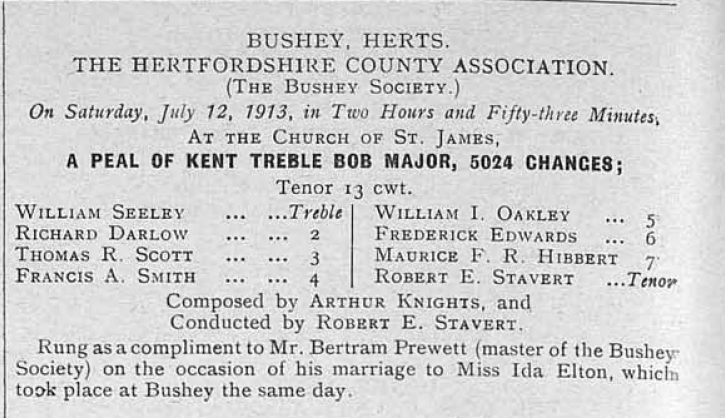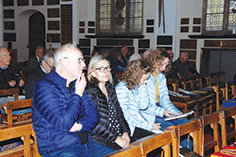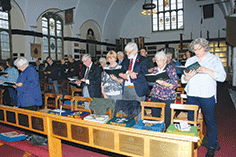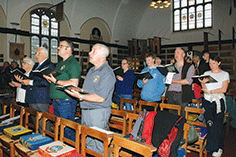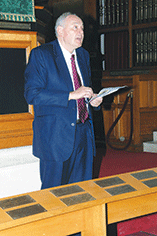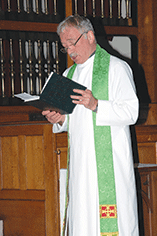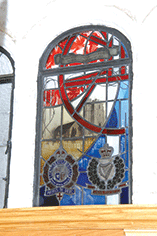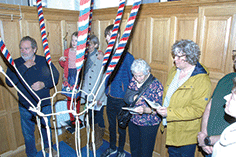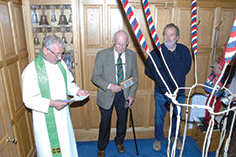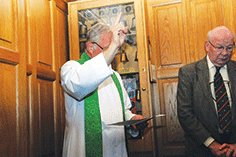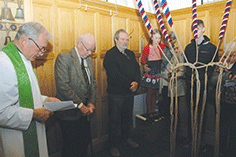
St George's Memorial Church,
Installation of the Prewett Window and it's Dedication
with grateful thanks to Alan Regin

On Sunday 23rd October we gathered at St George's Memorial Church for the Dedication of the Prewett Window. Alan Regin, who was responsible for the installation of the new ringing bells — see above — organised for the design and installation of the Prewett Window in the ringing loft.
Bertram was born in Hampstead, London, on 12th October 1878, only son of Jacob and Caroline Mary Prewett of Oxhey. He had a sister Florence. He was educated at Watford Grammar School from June 1886 to July 1894. He became a clerk in the Post Office before working for the GPO Savings Bank. From 1894 Bertram was becoming a well-known bellringer.
In Bushey Parish Magazine, August 1913 it was printed: Bushey Parish Church was the scene of a very pretty double wedding on Saturday, July 12 when Mr Bertram Prewett of Bushey was united to Miss Ida Lizzie Elton of Parfey Street, Fulham, and Mr William Franklin of Twickenham, to her sister, Miss Maud Mary Elton. The brides, who were dressed in white satin and carried bouquets of white carnations and lily-of-the-valley, were given away by their mother. A large company witnessed the ceremony, which was performed by the Rector, assisted by the Vicar of Oxhey. As each of the parties passed through the chancel and the nave, the organ played the Wedding March and the bells crashed forth a joyful peal. The whole company re-assembled at Buck’s Restaurant, Watford and thoroughly enjoyed the wedding breakfast. Mr and Mrs Prewett left at 4 pm en route for Scotland and Mr and Mrs Franklin for Shanklin.In the evening the Bushey Bell Ringers rang a peal of Kent double-bob-major in 2 hours 54 minutes. The previous Sunday Mr Prewett was presented with a very handsome barometer by the Bushey Church Officials and the Bell Ringers’ Band’.
Soon after war was declared Bertram Prewett joined the Rifle Brigade. Serving in France in 1917, he injured his foot but was able to cook for other in his Battalion. He wrote: "They went over the top the other night and took the village of B______, which has changed hands ten times lately. You can hardly imagine the ruin over here. Hardly a wall standing in the villages; fruit and other trees wantonly cut down; huge craters in the roads; and churches blown to pieces. In a village near here the only part of the church standing is the west end, and also a huge Crucifix in the churchyard. In the latter lay German and our dead side by side and I saw the grave of a Queen's man, surmounted by a cross, who had been buried by the Germans on 11th March last.
There are no traces of any bells – I expect they have gone to Essen for cannon. I saw, in a huge, ruined sugar refinery the stock and lever of the factory bell, but there was no trace of the bell itself. It is very hot out here now, and it is a great contrast to a month ago, when we had frost and snow. I'm glad to say that I am quite well, with the exception of my foot, but the life is rather trying.”
Bertram was wounded again on 23rd March 1918. Rifleman Bertram Prewett, aged 39, was killed in France on 31st August 1918. He is buried at the Sailly-Saillisel British Cemetery, IX.A.9, France. He left an estate of £981 18s 3d to his wife, approximately £85,000 today.
‘The death of Mr Bertram Prewett is a great loss to Bushey and the ringingworld in general. Born in Hampstead, he was brought as an infant to Bushey. He was educated at Watford Grammar School, at 16 years he won a place in the Civil Service. Mr Prewett began ringing at St Matthew’s Church at the early age of16. He rang nearly a thousand peals, two hundred and thirty six of which he himself conducted. He rang all over England and Ireland, in thirty seven counties, and in two hundred and forty towers. He was a member of the following associations – College Youths, Middlesex, Kent, Hertfordshire, Sussex and Midland counties. No one hated fighting more, but at an early date of the warhe offered himself and joined the Rifle Brigade. He was wounded in the German offensive on 23 March 1918. When in hospital at Etaples, his ward was heavily bombed and all its occupants killed. He had just gone out to help theorderlies. We offer our sincere sympathy to his aged father and mother, who live in Bushey Grove Road, and to his wife."
Bertram learnt to ring at Oxhey, where he was taught by George N. Price, and rang his first peal there, ringing the 4th to Grandsire Triples which George N. Price conducted. By the end of 1898, he had rung eight peals, the start of a glittering peal ringing career. At the time of his death, he had rung 953 peals in total, which included 880 tower bell peals and 73 handbell peals. He rang 495 peals of Stedman, 61 peals of Bristol S Major, 66 peals of London S Major, 164 peals of Superlative S Major and 3 peals of Cambridge S Maximus, including the first peal in that method at Ipswich on 15/08/1908. Long Lengths included 18,027 Stedman Caters at All Saints, Loughborough, on 20/03/1909, the first time the clock had been rung round by a single band; 15,264 Bristol S Major at St Andrew’s, Hornchurch on 27/05/1912; and on handbells, 6063 Stedman Cinques at The George IV, Brunswick Street, Haggerston on 22/03/1913, the longest length of Stedman Cinques in hand at that time. He rang exactly 100 peals during 1912. He conducted 236 peals of his peals. He went on several of William Pye’s peal tours around the UK and Ireland. In the back of his peal book, he records that he rang at 347 different towers, the entries for 1915 and 1916 include Cuckfield and Lindfield in Sussex, Wrentham and Covehithe in Suffolk, Mells in Somerset, and Sutton Veny and Warminster in Wiltshire, keeping ringing while he was serving in the Army.
Bertram is commemorated on the Bushey Memorial on Clay Hill, in the churches of St James and St Paul in Bushey and St Matthews, Oxhey.
